Sudarshana chronicles the perilous journey of millions of herbivores during the Great Migration in Tanzania’s Serengeti National Park, exclusively for Different Truths.
Acacia, baranite, cotton, and sausage trees dot the endless green-gold veld grassland, with random kopje breaks spread across. Highly poisonous candelabra cactus trees add to the allure. By mid-June, the long rains had taken leave of Serengeti National Park. A trail of forgotten clouds scowls over the windswept, drowsy grasslands, whimsically pulling its curtain over and off the patient sun.
June rushes the dry winter winds into Serengeti to wither up the sweeping savannah and shrivel up life-giving waterbodies. Over two million wildebeests, zebras, and other herbivores begin their stoic march for fresh pastures. Rains in neighbouring Maasai Mara in Kenya yoke them along with the promise of survival. The fact that each thirsty zebra and wildebeest needs a monumental amount of three gallons of water to drink every day explains the desperation of the herds.
We are in the heart of eastern Africa, saying Jambo Tanzania! to witness the largest animal migration in the world! Arusha is known as Tanzania’s safari hub. Having alighted in quaint Kilimanjaro airport in Arusha, we had been whisked away, in a tiny 12-seater Cessna aircraft, by a lone South African pilot aptly called Conrad, not to the heart of darkness, but definitely to the middle of nowhere, which we learnt was the Grumeti area.
The clockwise annual migratory trajectory from Serengeti to Maasai Mara and back to Serengeti is one of the seven wonders of the natural world. The action unfolds at Ndutu in Southern Serengeti, where the short grasses, rich in phosphorus, make it ideal for calving. More than five hundred thousand wildebeest calves are born between January and March every year, and baby zebras, impalas and gazelles to boot.
Life and Death
The stage is set for the drama to unfold. For visitors, to witness a kill, a river-crossing, or a desperate save is an unforgettable experience, while the animals providing the thrill, do so in the process of tangoing to the existential rhythm of life and death. The phenomenon can be traced back to the 1960s. It could have begun due to changes in climate and rainfall patterns, or an explosion in animal numbers, due to the eradication of rinderpest, which had been causing huge mortalities. Domestic herds were vaccinated, leading to the arrest of the virus.
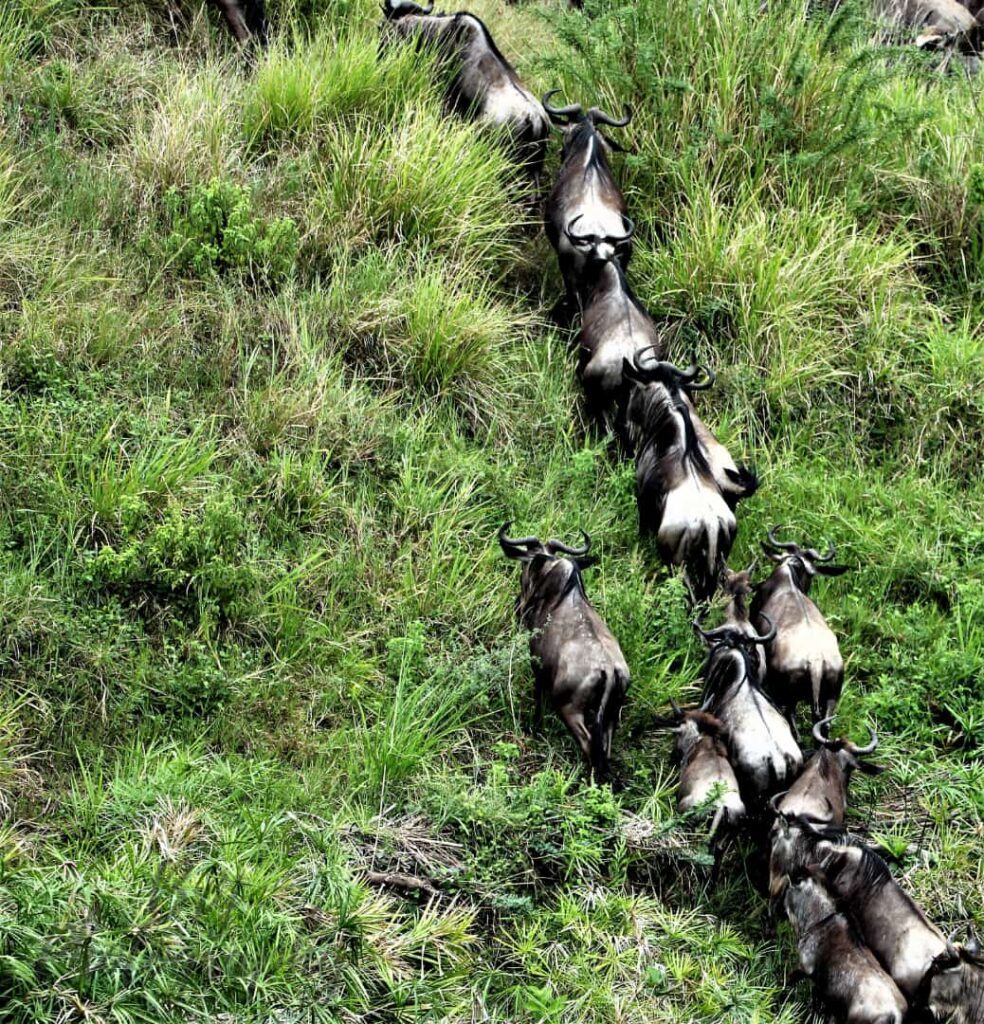
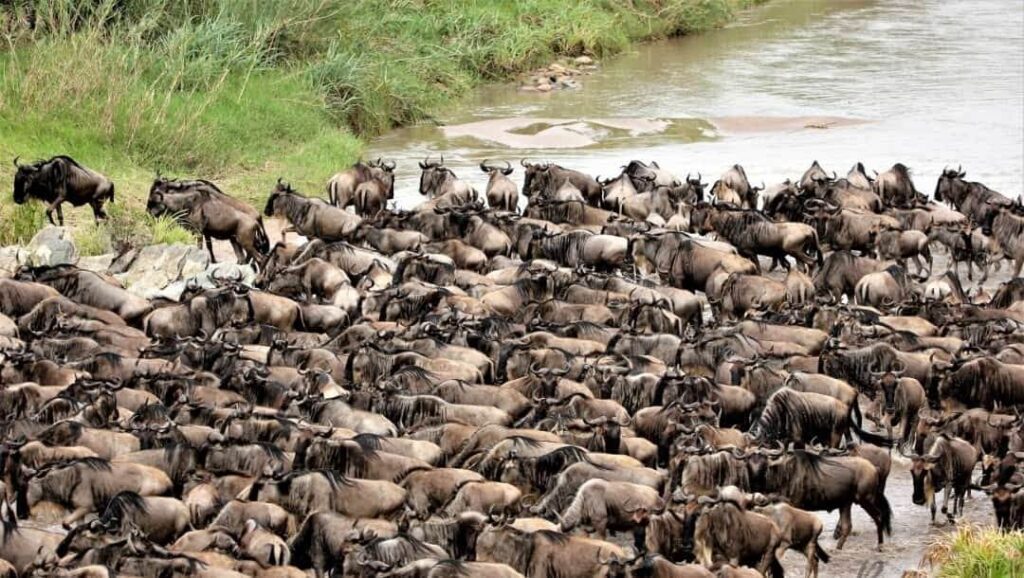
Serengeti Simba Lodge where we are put up, perched at a height, allows a 360-degree view of the surrounding openness. The migration tantalizes with an unexpected pre-breakfast teaser, as we spy a seemingly endless queue of the ungulates, clearly visible at a distance, trekking along. The lodge enjoys a ringside view of the migration, twice every year, on its way up and down. Beckoned thus, breakfast abandoned, we set out immediately, towards the Grumeti river. Packed into safari vehicles, Harley Frank, our driver/guide drives us to the migratory corridor to descend upon this idyllic morning scene.
Although its more famous sibling, Mara River, is the indisputable star, Grumeti flowing in western Serengeti is not to be trifled with. It flows along the migration trail in Tanzania, which the herds have to cross at least once on their route, a trial by water, before they navigate the mightier and more life-threatening Mara, swollen with rains and famished crocodiles.
Twelve of us are travelling in two vehicles with the entire expanse of land to ourselves. Herds upon herds of wildebeest are all around us, moving slowly and without the determination of the single file we had seen from the lodge. Scattered around, the sturdy bovids graze lazily. Picturesque zebras stand in pairs and fours, nose to tail, hugging each other in a fetching way, busy swatting flies off each other’s faces with long swishes of their tails. Most of Serengeti’s residents keep themselves busy, battling the relentless onslaught of flies.
Serengeti Migration
In Serengeti, migration usually happens between May and June. Herds travel with their surviving young, a brutal, calamitous struggle over a thousand arduous kilometres, dodging hungry predators, waiting on the prowl for the young and the weak. Numbers being huge, the herds organically group themselves to move in broadly three parts known as the head, body, and tail of the migration. Frank informs us that we are witnessing the head. The animals have no identifiable leaders and move ahead solely by swarming intelligence.
The calm is beguiling. Quietly, a cross-fade begins, as if a shiver has run down the collective spine of the milling herds, brought along on the wings of a snorted secret. The small herds coalesce, and stragglers are magnetically drawn to their clustered brethren. As we watch, the number of wildebeests dramatically soars. They abandon their idling gait, begin to trot, and then gallop down to the riverbank to our right. Scores, hundreds, then tens of thousands gather in a snap of fingers, a sea of heaving bodies. Frank drives to a maximum vantage point near a small bridge. On the bridge would perhaps have been best from the photographic point of view, but that is forbidden.
We content ourselves with being on the approach to the bridge. We are standing on our seats, looking out through the open pop-top roof of the vehicle, barely daring to breathe, in wild anticipation of a magical river crossing about to unfurl in front of our unblinking eyes. Will they cross? They are known to change their minds at the very last moment if the animals at the front of the herd demur.
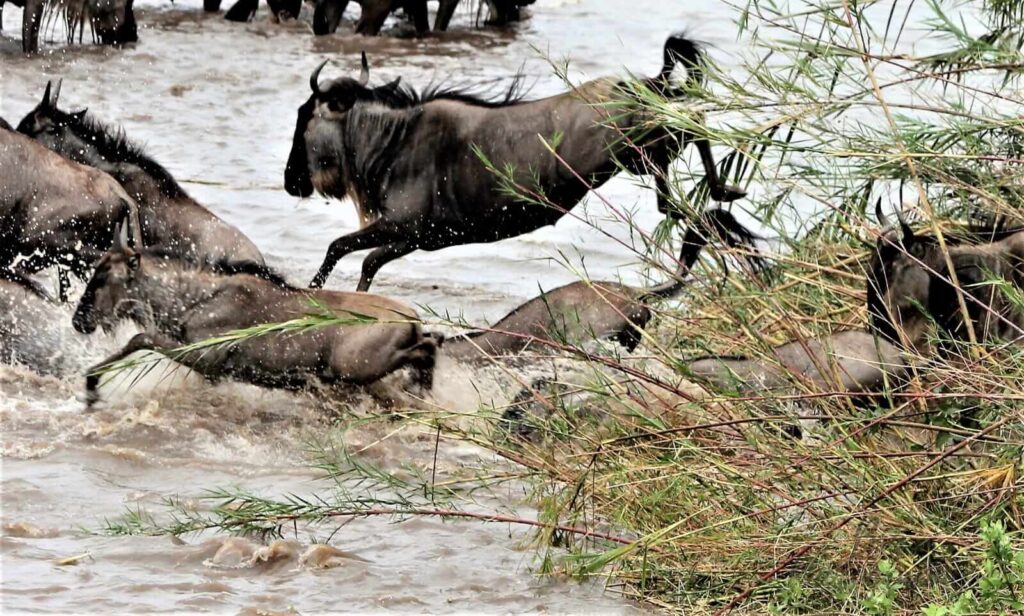
One animal ventures closer to the water’s edge and steps in gingerly, clearly testing. He does not turn back. A few other bellwethers would hold back no longer. They wade in, deeper into the river, keeping the first one company. The first lot crosses languorously, unperturbed. Lo and behold, the starting pistol has been sounded. The waiting masses pick up the silent command.
Magnificent Spectacle
On cue, hundreds jump into the fray, no time to lose. It turns into a tangle of bodies and horns, like a stampede. The urgency to get to the other side pulsates. They jostle each other, throwing themselves off the high banks with reckless abandon into the waters. An endless line of people forms behind those crossings, all moving purposefully in the direction of the river’s cleavage point by the crossing herds. Moments of unimaginable exhilaration. No camera can capture the cinematic magnificence of the spectacle.
The first lot steer clear of the water and come up dripping on the opposite bank, backs glistening ebony in the uncertain sunlight, while they cross the path a few meters ahead of us. A mesmerizing chant rises to a crescendo from the river, as the rest snort and bellow with frenetic, nervous energy. The sound of thirty or forty thousand bellows and the splash they make as they hit the water rent the air, ominous and soothing at the same time. The dust off their pounding hooves clouds over part of the action. The swell of their bodies is a large ink spill spreading across a wide swathe of the river.
Zebras join in, adding their charismatic symmetry to the chaotic ocean of browns.
We are fully aware of how incredibly lucky we are because the moment, the chosen place of crossing, and their mood are unpredictable. Even the local Maasai tribes cannot second guess the decision.
The frenzied river crossing behind them, all in the space of an hour, the crazed find their lost composure, as suddenly as they had lost it, and calmly continuing, gradually vanish into the hazy distance, melting away like a morning dream. It was as if it had never happened. Only the tall grass remains, swaying and shivering with the memory of the frantic storm of hooves and telltale innumerable hoof marks on the sandy shore to convince us, without us having to pinch ourselves.
A couple of vehicles drive past, filled with unsuspecting eager eyes, binoculars, and cameras, having missed the stupendous spectacle by minutes; ironically, not even knowing what they had missed, simply because they must have lingered over their breakfast, or woken up a tad late.
That’s how shifty a tryst with destiny can get in the Serengeti.
Tented Accommodation
Twilight brings us back to the comfort of our tented rondavel accommodation, sprinkled at multiple levels over the sprawling, hilly grounds. Twin-bedded, round structures with pointed thatched roofs that have double canvas walls, solid red foundation flooring, and sliding glass doors. Electricity is solar so that it wanes with the moon and all but vanishes at dawn. Armed Maasai guards are positioned at short distances and stay at their posts throughout the night, without whom we are not to step out of our rooms after dark in case of straying wild animals.
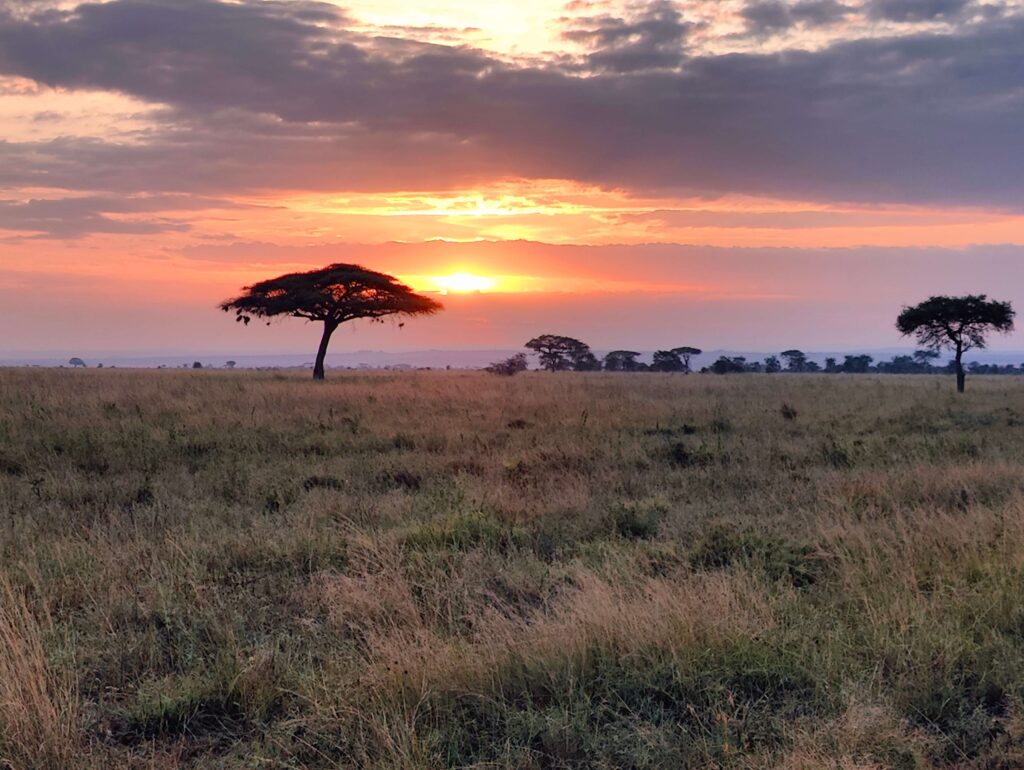
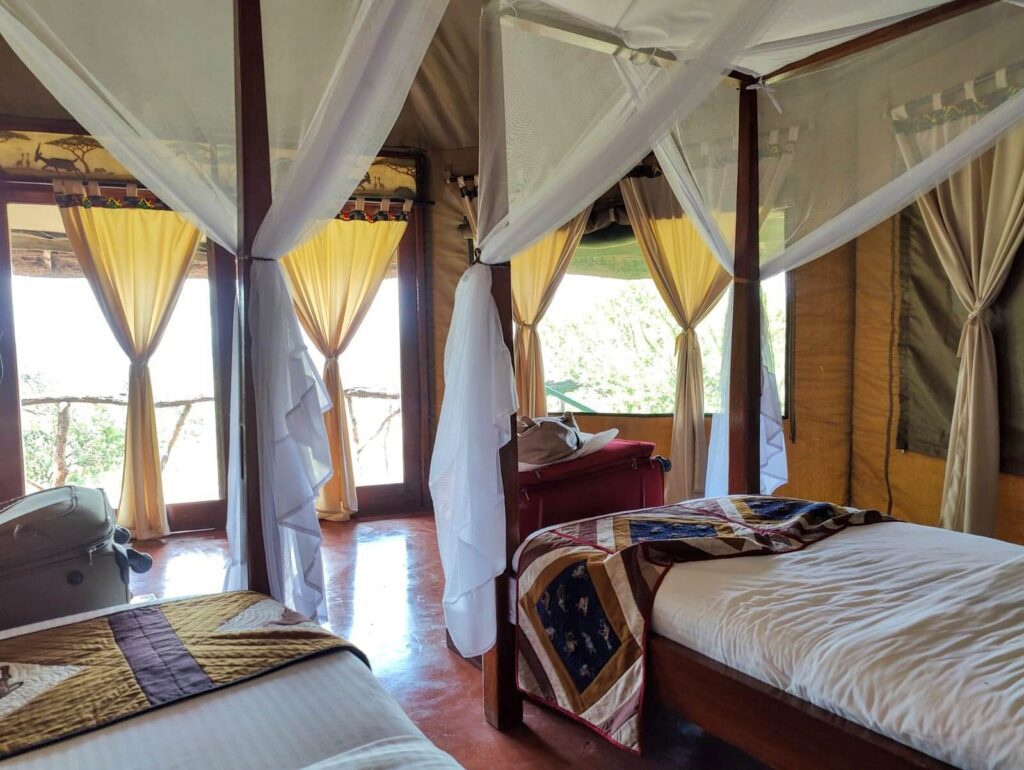
The outdoor stone shower is a novelty, with the possibility of animal company at bath times, from over the stone wall open to the sky, but their discretion allows us our privacy! We slumber each night to the whooshing of the wind, beating aggressively against the canvas walls, that merge with the occasional trumpeting, laughing of hyenas, and roaring, somewhere in the great beyond.
Two days later, one late afternoon, as we cross over to Central Serengeti, a somewhat lonely acacia stands vulnerable, on the edge of the earth. One burning orange sun descending on the horizon, through the umbrella branches sets the tree ablaze for a few flaming moments, before it will gather up the evening’s shadows within its boughs.
Quintessential Serengeti showing off with unmistakable pizzazz!
Pictures by the author





 By
By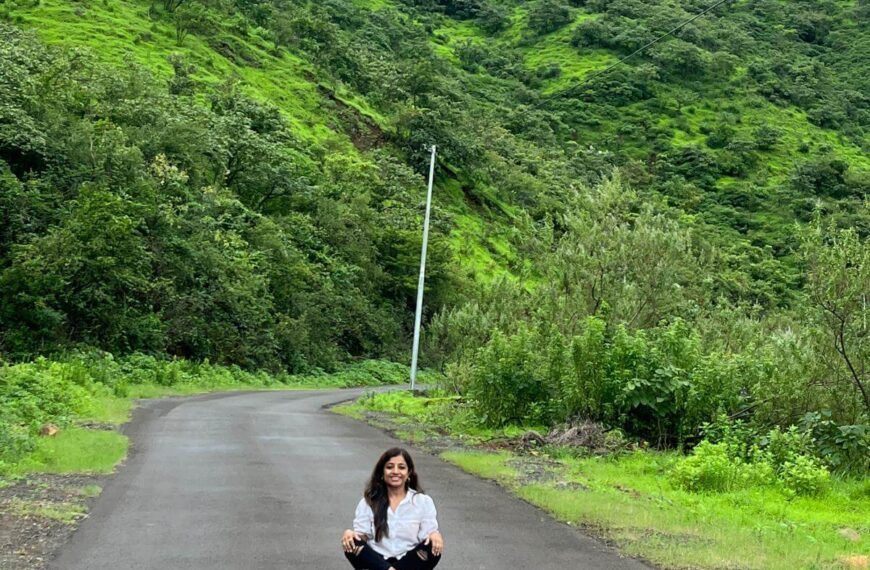


Such a womderful read!
What a wonderfully crafted travelogue, at once vivid and exciting , providing a ring-side view of the great drama of the migration. Apart from an eye for details and a wealth of information, what sets the piece apart from run- of-the-mill , seen that, done that kind of travelogue is the evocative use of language to bring it all alive. Terrific work Sudarshana. Yeh dil mangay more…